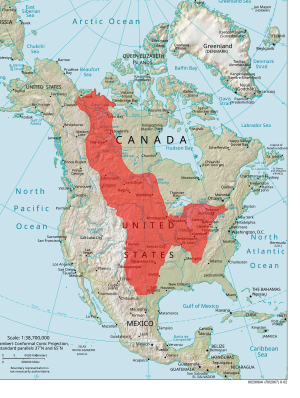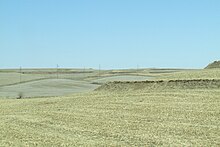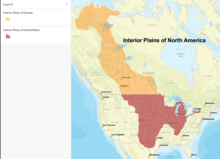Interior Plains

The Interior Plains is a vast
Geologic history
A series of tectonic plate collisions in the crust that formed the center of the North American continent laid the groundwork for the modern-day interior plains. Mountain building and erosion around the plains as well as flooding from inland seas provided sediments that make up the rock strata of the interior plains.
Proterozoic Eon (2500 to 539 million years ago)
Between 2.0 and 1.8 billion years ago the Hearne-Rae, Superior, and Wyoming cratons were sutured together to form the North American craton,
Paleozoic Era (539 to 252 million years ago)
This period has a large importance in Earth’s history as it saw the
Mesozoic Era (252 to 66 million years ago)
Around 220 MYA, the supercontinent Pangea broke apart, and the
Cenozoic Era (66 million years ago to Present Day)
The
Glacial history
2.6 million years ago at the start of the
Much of the loess distributed within the Interior Plains has its origin in glaciers. In glaciated conditions, sand and silt-laden meltwater originating from alpine glaciers in the Rocky Mountains generated alluvial deposits at their base. This alluvium was then distributed throughout the Interior Plains by strong winds.[11]
Sediment transport
Sediment transport within the Interior Plains occurs primarily by
Fluvial processes
Civil engineering projects have altered the fluvial geomorphology of the Interior Plains. Normal sediment transport by river and channel systems is interrupted by river-blocking structures such as dams and flow regulators. Before 1900, the estimated annual sediment transport by the Mississippi River to the Gulf of Mexico was 400 million tons.[19] However, in the early 20th century, engineering projects including dams were created on the Missouri River, meander cutoffs, river training, bank revetments, and soil erosion control have reduced the annual transport rate to between 100-150 million tons of sediment per year. The artificial structures trap suspended sediment from traveling as it would in an un-engineered river.[17]
Aeolian processes
While average annual temperatures vary significantly between the northern and southern portions of the Interior Plains, the climate is characterized by susceptibility to droughts due to generally low annual precipitation.[20]
Due to a warm climate and

Following World War I, wheat farming in the fertile loess soil of the Interior Plains swelled. The expansion of farmland eliminated many prairies containing soil-stabilizing grasses.[24] While droughts in the region were common,[20] during the following drought, aeolian soil erosion was exacerbated by the reduced soil-holding prairie grasses. Dust storms eroded hundreds of millions of tons of topsoil, causing dust storms for months in the historical region known as the Dust Bowl. On May 12, 1934 alone, an estimated 200 million tons of wind-eroded topsoil were transported to the Atlantic Ocean.[24]
In response to the rapid aeolian erosion, soil preservation methods were implemented. In the years following the Dust Bowl, 18,500 miles (29,800 km) of
Current land use
In Canada, provinces located within the Interior Plains produce nearly 60 percent of all beef cattle.[28]
Much of the land in the Interior Plains is used for
Other sources comprise much smaller portions of the land. In decreasing percentage, forests make up 5.8%, wetland makes up 1.6%, developed land makes up 1.5%, barren land makes up .6%, and land used for mining makes up .1%.[26]
Physiography

The Interior Plains physiographic area stretches across Canada and the United States, and the two governments each use a different hierarchical system to classify their portions. In Canada, the Interior Plains makes up one of seven physiographic areas included in the highest level of classification - defined as a "region" in that country. In the United States it is one of eight physiographic areas (of the contiguous 48 states) included in the highest classification, defined as a "division" there.[29][30]
Interior Plains in Canada
The Interior Plains of Canada are one of seven physiographic areas included in the highest level classification in that country. That country calls this primary classification level "region." For some of the seven regions, a subregion schema is provided. For other physiographic regions (such as the Interior Plains and Appalachian Uplands) subregions are not developed, but the tertiary level (called "division" in Canada) is used in the mapping data.[31]
The following list is of the 14 physiographic divisions in the Interior Plains of Canada. Further information can be found at https://atlas.gc.ca/phys/en/index.html
- Alberta Plain
- Alberta Plateau
- Anderson Plain
- Colville Hills
- Cypress Hills
- Fort Nelson Lowland
- Great Bear Plain
- Great Slave Plain
- Horton Plain
- Manitoba Plain
- Peace River Lowland
- Peel Plain
- Peel Plateau
- Saskatchewan Plain
Interior Plains in the United States
The following is a breakdown of the secondary (provinces), and tertiary (sections) physiographic areas of the Interior Plains portion in the United States:[32]
Central Lowland
- Dissected Till Plains
- Eastern Lake
- Osage Plains
- Till Plains
- Western Lake
- Wisconsin Driftless
Great Plains
- Black Hills
- Central Texas
- Colorado Piedmont
- Edwards Plateau
- High Plains
- Missouri Plateau, Glaciated
- Missouri Plateau, Unglaciated
- Pecos Valley
- Plains Border
- Raton
Interior Low Plateau
- Highland Rim
- Lexington Rim
- Nashville Basin
See also
References
- Canadian Encyclopedia. Retrieved June 2, 2019.
Interior Plains
- ^ a b "North America". Britannica. Britannica. Retrieved November 21, 2020.
- . Retrieved November 21, 2020.
- ^ Robison, Richard A.; Crick, Rex E. "Paleozoic Era". Britannica. Encyclopedia Britannica. Retrieved November 23, 2020.
- ^ "The Blue Ridge and Appalachian Mountains – A Geologic History". Blue Ridge Dream. Living the Blue Ridge Dream. Retrieved November 23, 2020.
- ^ Dykeman, Wilma. "Appalachian Mountains". Britannica. Encyclopedia Britannica. Retrieved November 23, 2020.
- ^ a b Slattery, Joshua S.; Cobban, William A.; McKinney, Kevin C.; Harries, Peter J.; Sandness, Ashley L. "EARLY CRETACEOUS TO PALEOCENE PALEOGEOGRAPHY OF THE WESTERN INTERIOR SEAWAY: THE INTERACTION OF EUSTASY AND TECTONISM". In Marron Bingle-Davis (ed.). Wyoming Geological Association 68th Annual Field Conference. Vol. 68. Wyoming Geological Association. Retrieved November 23, 2020 – via ResearchGate.
- . Retrieved November 23, 2020.
- . Retrieved November 23, 2020.
- ISBN 0813711517. Retrieved November 23, 2020.
- ^ a b Wayne, William J. "Glaciation". Encyclopedia of the Great Plains.
- ^ "Great Lakes Ecoregion". National Oceanic and Atmospheric Administration. Retrieved November 15, 2020.
- doi:10.1139/f75-234.
- .
- .
- ^ "MNLakes". MNLakes. Retrieved November 20, 2020.
- ^ hdl:11681/37073.
- .
- doi:10.1002/hyp.7477.
- ^ a b c Shafer, Mark; Ojima, Dennis. "Great Plains". National Climate Assessment. Retrieved November 12, 2020.
- .
- ^ "Sand Hills, Nebraska". NASA. Retrieved November 18, 2020.
- .
- ^ a b Hurt, R. Douglas. "Dust Bowl". Encyclopedia of the Great Plains. Retrieved November 3, 2020.
- ^ Brandle, James R. "Sheltebelts". Encyclopedia of the Great Plains. Retrieved November 3, 2020.
- ^ doi:10.3133/pp1794B.
- ^ Vinton, Mary Ann. "Grasses". Encyclopedia of the Great Plains.
- ^ a b c d Hudson, John C. "Agriculture". Encyclopedia of the Great Plains. Retrieved November 11, 2020.
- ^ "Physiographic divisions of the conterminous U. S. - ScienceBase-Catalog". www.sciencebase.gov. Retrieved November 12, 2023.
- ^ Secretariat, Treasury Board of Canada. "Physiographic Regions of Canada - Open Government Portal". open.canada.ca. Retrieved November 12, 2023.
- ^ Secretariat, Treasury Board of Canada. "Physiographic Regions of Canada - Open Government Portal". open.canada.ca. Retrieved November 16, 2023.
- ^ "USGS Science Data Catalog". data.usgs.gov. Retrieved November 16, 2023.
External links
- USGS map showing the subdivisions of the Interior Plains Province within the US
- Physiographic Regions, Canadian Encyclopedia(March 2015)
